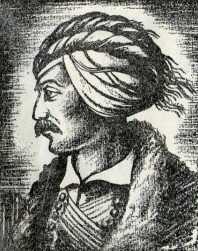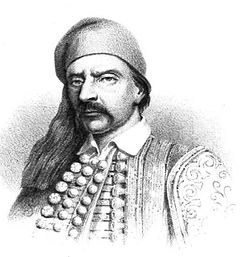Polina Spartyanova
One of the most famous Bulgarians who took part in the national liberation war of independence of Greece, Hadji Christos the Bulgarian was known as Christos Hadji Petros in Greek. Although he was one of the few heroes mentioned in Bulgaria, Greek society acknowledged Hadji Christos and a monument has been erected to the memory of the Bulgarian Soldier in Athens. His image is also depicted in a historical genre picture by artist Theodore Leblanc of the Greek struggle for independence entitled "Camp Des Grecs Palikares Devant Lepante" (Greeks before the Palikars camp, Lepanto), on which only the main commanders of the war are depicted. Today, the picture is housed at the French History Museum in Paris.

Hadji Christos the Bulgarian was born around 1790 in the village of Nissi, Voden region, which was part of the Ottoman Empire at the time, but located in the "Bulgarian outlying parts." At the beginning of his military career, he entered the Egyptian army of Albanian Mehmet Ali. During his service Hadji Christos was known for his bravery during fights with rebellious Arab tribes and became a cavalry commander in the army. Later, he was employed in Syria by Hurshid Ahmed Pasha who was appointed by the sultan as governor of the Peloponnese at the time. However, during the siege of Tripolitsa, the Bulgarian hero went over to the side of insurgent Greeks and headed the Bulgarian detachment participating in the Greek uprising. Precisely his detachment contributed to the defeat of the armies of Mahmud Pasha and the mastering of the Tripolitsa fortress. GRReporter recently wrote that every crucial battle in the Greek War of Independence involved Bulgarians.
In his book "History of Bulgaria: Military history of the Bulgarians from ancient times" Georgi Bakalov presents the exploits of Hadji Christos in the battles in Fthiotida, Thermopylae, Budnitsa and Nafplio. According to the author, his biggest success was achieved at the Dervenaki entrance where Turkish forces suffered one of their worst defeats. The Greek biographer of Hadji Christos wrote: "This detachment carried out huge proven feats, one of which was the famous feat at Dervenaki on 26 July and 27 July 1822. In 1823, the detachment of Hadji Christos won another victory over the Turkish troops at Kromidi. In the battle of Navarino he was captured and imprisoned in one of the dungeons of the castle of Methoni. But his authority was so great that one of the conditions of the allies of the United Navy of Russia, England and France, which defeated the Ottoman fleet at Navarino, was the release of Hadji Christos. After that he was greeted as a hero in the then capital of Greece - the island of Aegina. Later, a government decree of 1833 read that "From now on, as a sign of gratitude, part of the Methoni castle will be named after Hadji Christos."

Hadji Christos created the first Greek irregular cavalry, which later contributed to the liberation of Greece and became the first head of the Greek cavalry. For this reason, in 1824, he received a general's rank and accolades. In early 1834, Hadji Christos was one of the first to be awarded the highest medal "for the bravery he showed in all the battles and especially in the battle at Dervenaki as a commander of the Bulgarian detachment." After the liberation of Greece from Ottoman rule, the brave Bulgarian actively participated in the creation of the free Kingdom and became adjutant of King Otto I. In 1843, he was elected MP in the Greek Parliament as a representative of Thrace, Bulgaria and Serbia. He remained in Athens in order to serve the newly forming Greek society until the end of his days - he died in 1853.
In his article "Hadji Christos the Bulgarian" George St. Georgiev quoted a British General who said: "Those who fight for Greek freedom are not Moreans (residents of Morea, the Peloponnese) or Greek Byzantines, but people of Albanian race and that of the North. Under the command of Hadji Christos, their cavalry involves Bulgarians. The only good infantry consists of Suliots (from the city of Sula in Albania) and Rumeliots (i.e. Bulgarians from Rumelia)."